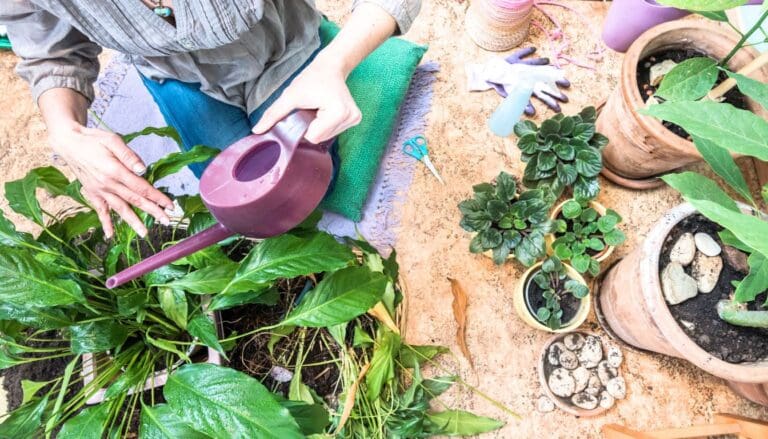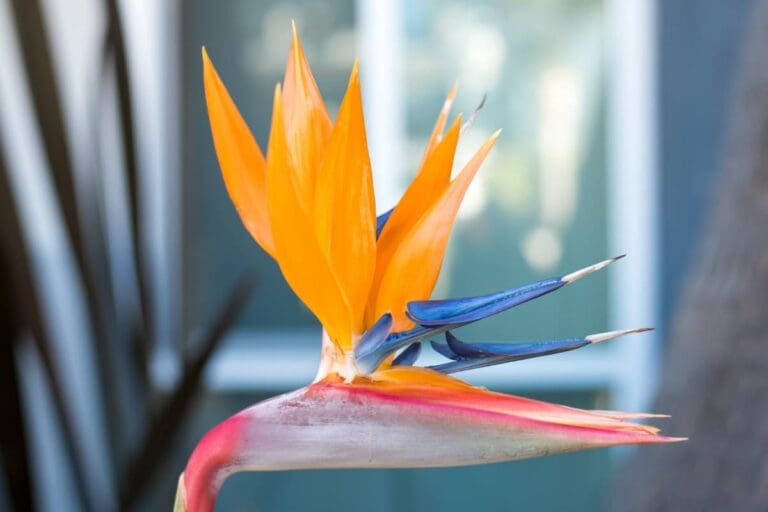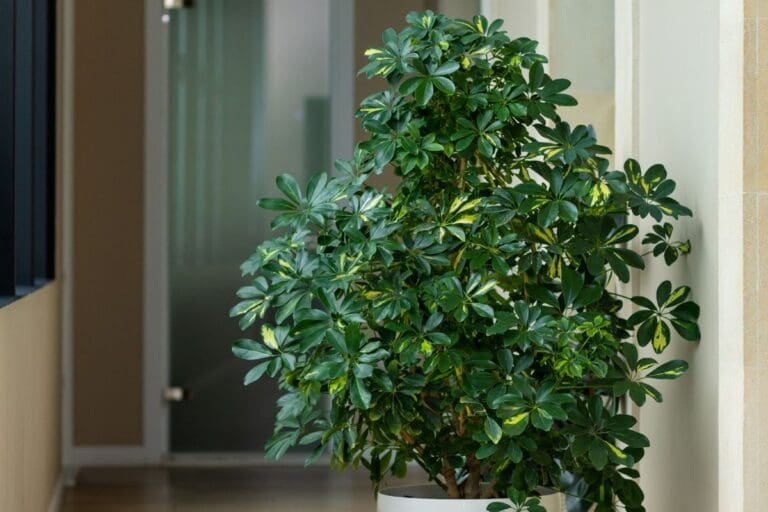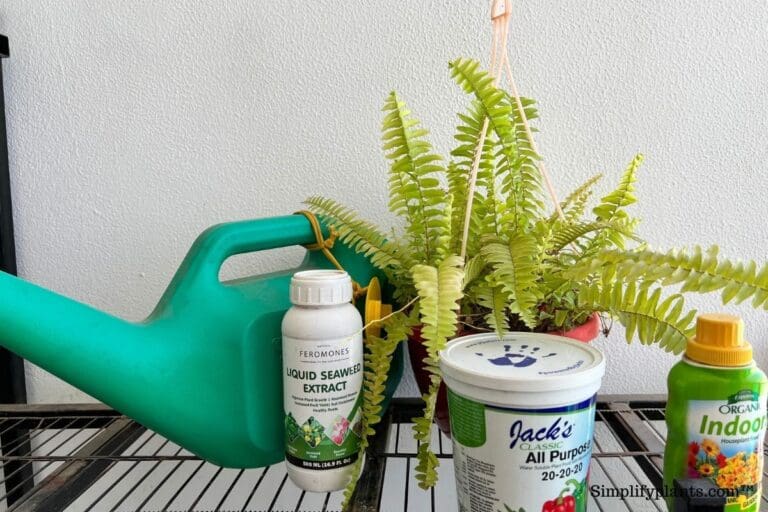How To Fertilize English Ivy? (Best Fertilizer+FAQs)
English Ivy plants are evergreen climbing perennials that are widely loved for their beautiful leaves and tolerance to different conditions. If you are growing one in your house or plan to bring one, you should know how to care for it. And one important part of its care routine is fertilization.
To fertilize your English Ivy plant:
- Get a 20:20:20 NPK liquid fertilizer.
- Dilute the fertilizer with water in a watering can.
- Add it to the soil every 2 weeks during the growing season.
- If you are using compost, mix a handful of it with the soil.
- Never fertilize an unhealthy or weak plant.
This article will discuss the importance of fertilizing: how to fertilize the English Ivy, the best fertilizers, and ways to fix your overfertilized plant.

Please note: Simplify Plants is reader-supported. Some links in the post are affiliate links and I get a commission from purchases made through links in the post.
Does English ivy need to be fertilized?
English ivy plants require low maintenance and don’t demand heavy fertilization.
In the wild, they grow without any fertilization.
But when you grow them in pots, they cannot access the earth’s natural nutrients and are restricted to the soil in the pot.
With regular watering and erosion, the nutrients in the soil begin to wash away with time, thus reducing the plant’s growth.
This is why fertilizing potted English ivy becomes important.
Even though English ivy can grow without feeding, fertilizing them gives a boost of nutrients and, thus, growth.
I recommend feeding your English Ivy during its growing season, spring to summer, with diluted liquid fertilizer.
However, if you have repotted your English Ivy recently and have already mixed compost with the potting soil, you do not need to feed it immediately and wait for 2-3 months to feed it again.
What happens if I do not fertilize my English Ivy?
Fertilization in the growing season is important to help the plants get the nutrients for growth.
If you do not fertilize your English ivy, it will show signs of stress like:
- Leggy growth
- Slow growth
- Droopy leaves
- Pale discolored leaves
- Smaller leaves
- Thin, weak branches
- Weak roots
All these happen because the plant becomes weak without enough nutrients due to no fertilization.
So if you notice such signs in your English Ivy and know you have not fed your plant for long, consider fertilizing it.
However, remember not to fertilize in the fall or winter.
What nutrients does English Ivy need?

Different types of fertilizers are available in the market with beneficial elements for the plants.
Houseplants like English Ivy need some specific nutrients from fertilizers.
A clear understanding of it will help you choose the ideal fertilizer for your Ivy.
| Nutrients | Elements |
|---|---|
| Macronutrients | Potassium, phosphorous, nitrogen |
| Micronutrients | Nickel, zinc, iron, copper, manganese, boron |
| Other nutrients | Magnesium, sulfur, calcium |
Macronutrients
Macronutrients are the most important and popular form of nutrients for houseplants.
They need it for multiple activities like photosynthesis, cell development, and protein synthesis.
The NPK we feed our plants contains these macronutrients: Nitrogen, Phosphorous, and Potassium.
Micronutrients
Plants need micronutrients in lesser quantities than micronutrients to help them to grow faster.
Types of fertilizers
There are primarily 2 types of fertilizers available in the market: naturally-derived organic fertilizers and chemically-created inorganic fertilizers.
Now let us read about them in more detail.
Organic fertilizer
Organic fertilizers are best for your plants because they do not contain any synthetic chemicals.
Due to this, they don’t pose any threat to your plants.
Organic fertilizers are derived from natural sources and are a completely safe and organic way to add nutrients to your plants.
They are used by people who do not want to add chemicals to their plants.
However, their results are slower than inorganic fertilizers.
Let s discuss some of the popular and commonly used organic fertilizers in the market.
Compost

Organic compost is made of dried leaves, kitchen waste, etc.
It transforms the raw organic residues into humus-like material with the help of microorganisms.
They not only add nutrients but also improve the soil quality and are used for mulching the soil.
The various benefits of using organic compost are:
- Improves microbial activities in the soil
- Increases the fertility of the soil
- Compost releases its nutrients slowly over time and gives long-term results.
- Compost buffers the soil by neutralizing acid and alkaline soil.
- Increases the plant’s resilience in suppressing diseases
- Helps sandy soil retain water and nutrients
- Improves the soil quality of clayey soil by loosening
- Improves the health of the root system
- Reduces the usage of chemical fertilizers
Coffee grounds
Coffee grounds are an excellent way to add Nitrogen and other nutrients to your English Ivy.
It improves the quality of the soil by improving drainage, water retention capacity, and aeration in the soil.
It creates an environment that attracts earthworms to the soil.
Plants like English Ivy that prefer slightly acidic soil will enjoy coffee grounds.
The best way to add coffee grounds is by adding them to the compost.
You should mix the compost very well with the soil so the coffee grounds don’t stay exposed to the air.
You can add the coffee grounds to hot water, simmer it for some time, let it cool down, and strain and use it.
Banana peels
Banana peels are rich in vitamins and minerals and contain a high amount of potassium, nitrogen, and phosphorous.
You can add it in different ways like:
- Banana peel water: Chop some banana peels, mix them in a jar of clean water, and let them sit for a week. You will notice the water getting brown as the nutrients break down from the peels. Pour this water on your plants.
- Banana peels in the compost: You can make compost with banana peels.
- Burying the peels in the soil: Chop in pieces of peels and bury them in the soil.
Eggshells

Eggshells are a fantastic way to fertilize your Ivy.
You can make fertilizer from the crushed egg shells, which have a high calcium carbonate content, vital for strengthening the plant cells.
They also have a high content of magnesium, potassium, and phosphorous.
Eggshells absorb toxic elements like aluminum from the soil.
If the soil has a high pH level, use eggshells to lower it.
The smell of the eggs repels pests from invading your plants, and the sharp edges of the crushed shells prevent pests like snails and slugs from invading.
The high calcium carbonate in the eggshells helps the plant’s roots grow faster and stronger.
The best way to add the eggshells is by crushing them into a powder and adding it to the boiling water.
Keep this mixture covered for a week.
After that, stir it well and add the mixture to the plants.
Aquarium water
Instead of throwing away the dirty water after cleaning your fish tank, use it to water your English Ivy.
This water promotes the growth of your plants.
The poop of the fish is very rich in nitrogen and acts as a good fertilizer for your Ivy.
Inorganic fertilizer
Inorganic fertilizers are created synthetically and contain various synthetic chemicals and minerals.
There are three types of inorganic fertilizers:
Slow-release fertilizer

Slow-release fertilizers are perfect for outdoor plants or landscape gardens.
As the name suggests, slow-release fertilizers release the nutrients slowly over time, not all at once, so their results are more long-lasting.
However, they are quite high in nutrient content.
Therefore, you must be careful while applying these.
Slow-release fertilizers are mostly recommended for outdoor plants, not houseplants.
They will release the nutrients every time you water your English Ivy.
Granular fertilizer
Granular fertilizers come in pellets that are added to the soil.
They contain a high quantity of potassium and nitrogen.
Thus, you must use them carefully, or the high dosage of elements can potentially burn your plants.
Read the correct procedure and instructions before usage.
Liquid fertilizer

Liquid fertilizers are used most widely for houseplants.
They come in powder and liquid forms, which must be mixed with water and given to the plants by watering or spraying the foliage.
You can dilute the proportion of the fertilizer depending on the plant’s need.
Chances of over-fertilization or root burn are lower with liquid fertilizers because the roots can easily absorb them.
How to fertilize the English Ivy?
Many plant growers find it daunting to add correct fertilization to their plants, but this section will make it easy for you.
Take a look at the steps you should follow to fertilize your English Ivy.
- First, you need to select the type of fertilizer. My recommendation is to rotate between organic and inorganic fertilizer.
- Before ordering or buying the fertilizer from the market, do thorough research on the requirements of your Ivy.
- Water your English Ivy a day before fertilizing. Do not fertilize in dry soil as that can lead to root burn. Moist soil helps absorb the fertilizer well.
- If you use a synthetic chemical fertilizer, read the instructions carefully and dilute it to half strength to avoid overfertilization.
- You can add the fertilizer to the water of the watering can and add it to the soil.
- If you wish to use organic compost, take a handful and mix it well with the soil.
- If you choose to use both fertilizers, use an organic one after using inorganic fertilizers 2-3 times.
When should I fertilize my English Ivy?
You should fertilize your plants when they are growing at their peak.
Fertilizing plants is recommended during the active months because the plant utilizes the extra nutrients from the food and uses them to push out more growth.
The plants get less active in the fall and winter, and some stay dormant due to the lower temperature and low light intensity.
Fertilizing the plant during this time keeps the fertilizer unused in the soil, increasing the chances of root burn.
So feed your English Ivy during the spring and summer and withhold feeding it in winter and fall.
Feeding your English Ivy with a slow-release fertilizer or compost once in March and once in September is ideal.
And every month during the growing season, you can use a balanced diluted liquid fertilizer.
What is the best fertilizer for English Ivy?

Every plant has a different need, so their need for fertilizers also depends on the requirements.
Different fertilizers are available in the market, but you must choose according to the need of the English Ivy.
I have listed Some of the best fertilizers for your English ivy:
- Miracle-Gro Water Soluble All Purpose Plant Food
- J R Peters 52024 Jacks Classic No.1.5 20-20-20 All Purpose Fertilizer
- Espoma Company Organic Indoor Plant Food
You must know the ratio of the macronutrients in the fertilizer, which are Nitrogen, Phosphorous, and Potassium, which are the nutrients in NPK.
The wrong dosage of these nutrients can damage your plant by overfertilizing or burning it.
Therefore, before buying the fertilizer, check the ratio and the right way and dosage to apply it to your plant.
English Ivy is not a heavy feeder and can grow without fertilizer.
However, adding fertilizers improves its health and growth rate.
So if you overfertilize it, it will have a chance of getting damaged.
The ideal fertilizer for your English Ivy has an NPK 20:20:20.
The table below explains each macronutrient’s role in your English Ivy’s growth.
| Nutrients | Functions |
|---|---|
| Nitrogen (N) | Root growth Promotes foliage growth Encourages protein synthesis Encourages photosynthesis |
| Phosphorous (P) | Helps in root development Helps in water regulation in the plant |
| Potassium (K) | Makes the plant stronger and resilient Encourages smooth flow of nutrients Improves immunity |
While putting the fertilizer on your English Ivy, always dilute it to reduce its strength, so the chances of over-fertilization reduce.
You can also use a slow-growing fertilizer for your English Ivy in the growing season.
However, check its dosage as they are highly potent.
What if I overfertilize my English Ivy?

Overfertilizing can damage any plant, even more than under-fertilization.
English Ivy being medium feeders, does not need heavy feeding.
Beginners very often make this mistake.
Overfertilization occurs in situations when:
- You fertilize your English Ivy too frequently.
- You use a dose of fertilizer that is too potent for your Ivy.
- You feed your English Ivy when it is dormant in the fall and winter months.
- You fertilize an already stressed or unhealthy plant.
If you have overfed your English Ivy, it will show signs like:
- Wilting
- Browning of the leaves
- Reduced growth
- A white layer of powdery build-up on the topsoil
How to fix an overfertilized English Ivy?
If you have made the mistake of overfertilizing your English Ivy, this is how you should fix it:
- First, stop fertilizing immediately.
- Take the plant out of the pot and examine its roots.
- Prune the leaves and stems that look brown or burnt.
- If the topsoil has accumulated white salt buildup, then scrape it.
- Wash the plant under running water thoroughly to remove all the fertilization build-up
- Repot the English Ivy in a fresh mix by combining the soil with perlite, sand, and compost.
- Do not fertilize it for 3-4 months as the soil already has fertilizer.
- Resume fertilizing once the plant shows new growth and recovers.
Final words
Fertilization is an important part of caring for your plants. A plant not fed will suffer from issues like a feeble body, no growth, etc. Like the human body, your English Ivy will also need nutrients and minerals to flourish.
Fertilize your English Ivy with a 20:20:20 NPK liquid fertilizer in the growing season. If you are a beginner, start gradually with a smaller dose if unsure. You can increase the procedure and dosage as needed as you learn the procedure and dosage.
Remember, overfertilization is more damaging than under-fertilization, so keep the above information in mind and start slowly.
Reference: Researchgate, University of Tennessee, Mississippi State University, Central Florida Research and Education Center, U.S. DEPARTMENT OF AGRICULTURE.
Recommended Garden Supplies
| Product Image | Our Recommended Gardening Supplies | Check Offers! |
|---|---|---|
Top Top
Top
Top
Top
Top
Top
Top
Top | rePotme Houseplant and Tropical Classic Potting Soil Mix | Check Offer On Amazon |
 Top
Top
Top
Top
Top
Top
Top
Top | Espoma Organic Indoor Plant Food | Check Offer On Amazon |
 Top
Top
Top
Top
Top
Top
Top
Top | GooingTop LED Grow Light 6000K Full Spectrum Clip Plant Growing Lamp | Check Offer On Amazon |
 Top
Top
Top
Top
Top
Top
Top
Top | Soil Moisture Meter | Check Offer On Amazon |
 Top
Top
Top
Top
Top
Top
Top
Top | Govee Hygrometer Thermometer, Bluetooth Enabled! | Check Offer On Amazon |
 Top
Top | LEVOIT Humidifiers for Large Room(Best For Plants) | Check Offer On Amazon |
 Top
Top
Top
Top
Top
Top
Top
Top | Upgraded DIY Automatic Drip Irrigation Kit, 15 Potted Houseplants Support | Check Offer On Amazon |
 Top
Top
Top
Top
Top
Top
Top
Top | Stainless Steel Heavy Duty Gardening Tool Set | Check Offer On Amazon |
 Top
Top
Top
Top
Top
Top
Top
Top | Bonide Insecticidal Soap | Check Offer On Amazon |
 Top
Top
Top
Top
Top
Top
Top
Top | Bonide 32 oz Spray Neem Oil for Organic Gardening | Check Offer On Amazon |
 Top
Top
Top
Top
Top
Top
Top
Top | Garden Safe Fungicide | Check Offer On Amazon |






